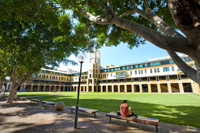This is a shelf course. A shelf course comprises a number of modules related to this broad area of study. Each module is a separate semester of study in this area and is offered in rotation. You can study TWO modules but you cannot study the same module twice.
|
Subject Areas: Women's and Gender Studies
This course can also be studied in the following specialisations: Asian Studies; History; Japanese Studies*
Module: "Premodern Japan: Status, Sex and Power" (Semester 2, 2011)
*Note: Only this module contributes to Japanese Studies
'Premodern Japan' offers a thematic overview of Japanese history from prehistory to the Meiji Imperial Restoration of 1868, its central theme being the history of women, gender and sexualities.
The course includes a focus on historiography—a consideration of central issues in global women's and gender history, as well as different approaches to Japan's history. Since the course is essentially a cultural and social history, we will not only discuss the ideas and social practices of ruling classes (civil aristocrats and then bushi/warriors), but also look at popular Buddhism, folk religion, peasant rebellion and commoner resistance, and aspects of popular culture. The weekly topics are more varied than the subtitle of ‘Status, Sex & Power’ would suggest, though central themes in the course include the situation(s) and role(s) of Japanese women of different classes from ancient times; gender constructs (of femininity and masculinity) in the literature of different classes and in scripture; and attitudes toward sex and marital and sexual practices.
Module: "Women in Southeast Asia"
This course explores women’s status and roles in politics, history, culture, economy, religion and the family, in several countries of the Southeast Asian region. It will examine women and unofficial power (eg. women who hold power as wives of male politicians like former First Ladies Imelda Romualdez Marcos for example) women in official power such as women politicians, and women’s movements. It addresses the controversial issues of women’s victimisation like prostitution in Thailand and the Philippines, ‘mail-order brides’ and domestic helpers as well as reproductive health or reproductive rights including ‘family planning' and abortion. Finally the subject grapples with cultural constructions of the feminine (including how authoritarian regimes define it), as women negotiate the definitions of woman as wife and mother, as ‘bearer of sons’, as beauty queen, as bearer and wearer of tradition, and as worker. Issues of gender, ‘modernity’ and national identity are raised when we discuss women and the veil in Malaysia and the role of gender in the formation of national identity.

